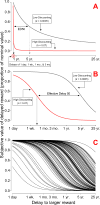Clinical models of decision making in addiction
- PMID: 28851586
- PMCID: PMC5747979
- DOI: 10.1016/j.pbb.2017.08.010
Clinical models of decision making in addiction
Abstract
As research on decision making in addiction accumulates, it is increasingly clear that decision-making processes are dysfunctional in addiction and that this dysfunction may be fundamental to the initiation and maintenance of addictive behavior. How drug-dependent individuals value and choose among drug and nondrug rewards is consistently different from non-dependent individuals. The present review focuses on the assessment of decision-making in addiction. We cover the common behavioral tasks that have shown to be fruitful in decision-making research and highlight analytical and graphical considerations, when available, to facilitate comparisons within and among studies. Delay discounting tasks, drug demand tasks, drug choice tasks, the Iowa Gambling Task, and the Balloon Analogue Risk Task are included.
Keywords: Balloon Analogue Risk Task; Decision-making; Delay discounting; Drug choice; Drug demand; Iowa Gambling Task.
Copyright © 2017 Elsevier Inc. All rights reserved.
Figures


Similar articles
-
Discounting delayed monetary rewards and decision making in behavioral addictions - A comparison between patients with gambling disorder and internet gaming disorder.Addict Behav. 2020 Sep;108:106446. doi: 10.1016/j.addbeh.2020.106446. Epub 2020 Apr 25. Addict Behav. 2020. PMID: 32408114
-
Translational Models of Gambling-Related Decision-Making.Curr Top Behav Neurosci. 2016;28:93-120. doi: 10.1007/7854_2015_5014. Curr Top Behav Neurosci. 2016. PMID: 27418069 Review.
-
Dopamine D3 Receptors Modulate the Ability of Win-Paired Cues to Increase Risky Choice in a Rat Gambling Task.J Neurosci. 2016 Jan 20;36(3):785-94. doi: 10.1523/JNEUROSCI.2225-15.2016. J Neurosci. 2016. PMID: 26791209 Free PMC article.
-
Think twice: Impulsivity and decision making in obsessive-compulsive disorder.J Behav Addict. 2015 Dec;4(4):263-72. doi: 10.1556/2006.4.2015.039. J Behav Addict. 2015. PMID: 26690621 Free PMC article.
-
Neuropsychological Interventions for Decision-Making in Addiction: a Systematic Review.Neuropsychol Rev. 2019 Mar;29(1):79-92. doi: 10.1007/s11065-018-9384-6. Epub 2018 Sep 26. Neuropsychol Rev. 2019. PMID: 30259388
Cited by
-
Behavioral economic tobacco demand in relation to cigarette consumption and nicotine dependence: a meta-analysis of cross-sectional relationships.Addiction. 2019 Nov;114(11):1926-1940. doi: 10.1111/add.14736. Epub 2019 Aug 18. Addiction. 2019. PMID: 31313403 Free PMC article. Review.
-
Neurocognitive Correlates of Adolescent Cannabis Use: An Overview of Neural Activation Patterns in Task-Based Functional MRI Studies.J Pediatr Neuropsychol. 2020 Mar;6(1):1-13. doi: 10.1007/s40817-020-00076-5. Epub 2020 Jan 20. J Pediatr Neuropsychol. 2020. PMID: 33425663 Free PMC article.
-
Decision-Making in Gambling Disorder, Problematic Pornography Use, and Binge-Eating Disorder: Similarities and Differences.Curr Behav Neurosci Rep. 2020 Sep;7(3):97-108. doi: 10.1007/s40473-020-00212-7. Epub 2020 Jun 27. Curr Behav Neurosci Rep. 2020. PMID: 33585161 Free PMC article.
-
Estimating Uptake for Reduced-nicotine Cigarettes Using Behavioral Economics.Tob Regul Sci. 2019 May;5(3):264-279. Tob Regul Sci. 2019. PMID: 40271538 Free PMC article.
-
Human laboratory models of reward in substance use disorder.Pharmacol Biochem Behav. 2024 Aug;241:173803. doi: 10.1016/j.pbb.2024.173803. Epub 2024 Jun 4. Pharmacol Biochem Behav. 2024. PMID: 38843997 Free PMC article. Review.
References
-
- Acker J, MacKillop J. Behavioral economic analysis of cue-elicited craving for tobacco: a virtual reality study. Nicotine Tob. Res. 2013 http://dx.doi.org/10.1093/ntr/nts341. - DOI - PMC - PubMed
-
- Ainslie G. Specious reward: a behavioral theory of impulsiveness and impulse control. Psychol. Bull. 1975;82:463–496. http://dx.doi.org/10.1037/h0076860. - DOI - PubMed
-
- Alessi S, Greenwald M, Johanson C. The prediction of individual differences in response to D-amphetamine in healthy adults. Behav. Pharmacol. 2003;14:19–32. http://dx.doi.org/10.1097/01.fbp.0000054302.62624.cc. - DOI - PubMed
-
- Amlung M, MacKillop J. Understanding the effects of stress and alcohol cues on motivation for alcohol via behavioral economics. Alcohol. Clin. Exp. Res. 2014;38:1780–1789. http://dx.doi.org/10.1111/acer.12423. - DOI - PMC - PubMed
-
- Amlung M, Acker J, Stojek MK, Murphy JG, Mackillop J. Is talk “cheap”? An initial investigation of the equivalence of alcohol purchase task performance for hypothetical and actual rewards. Alcohol. Clin. Exp. Res. 2012;36:716–724. http://dx.doi.org/10.1111/j.1530-0277.2011.01656.x. - DOI - PMC - PubMed
Publication types
MeSH terms
Grants and funding
LinkOut - more resources
Full Text Sources
Other Literature Sources
Medical
Research Materials

